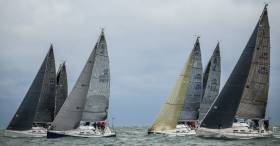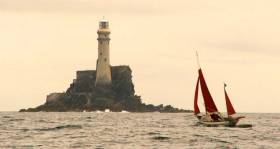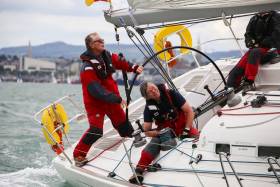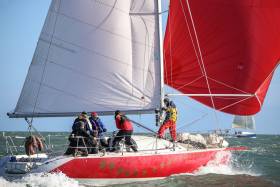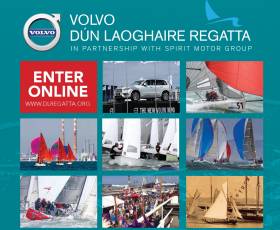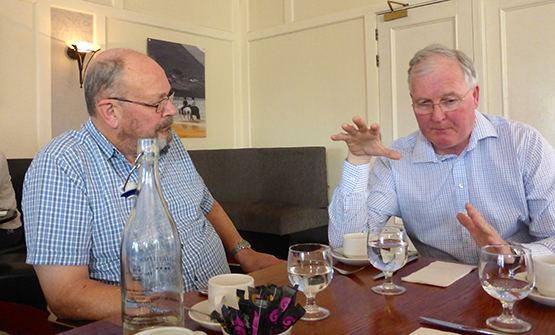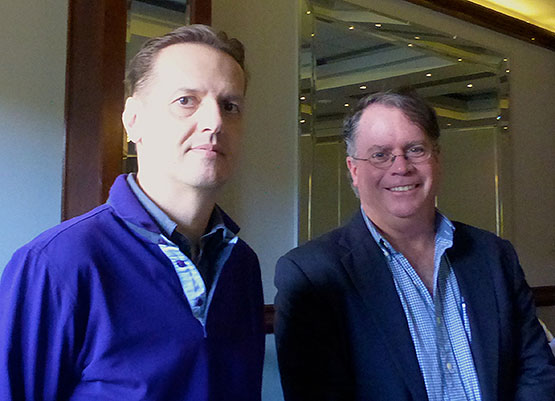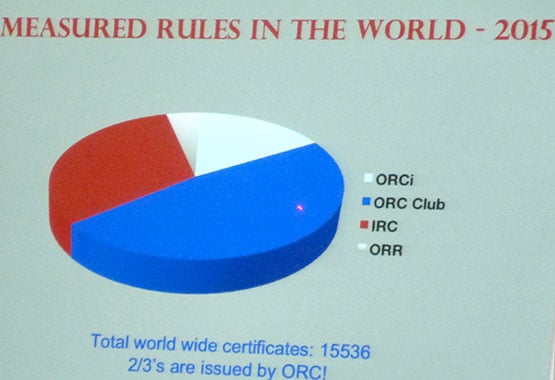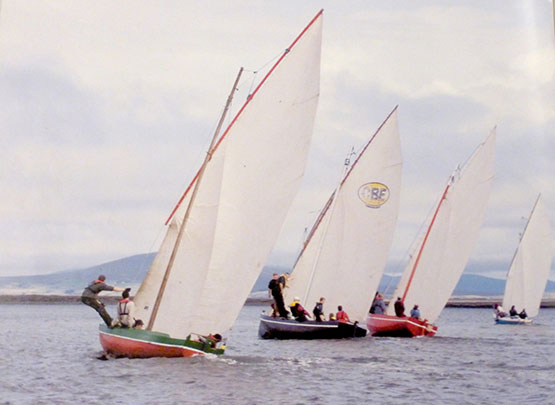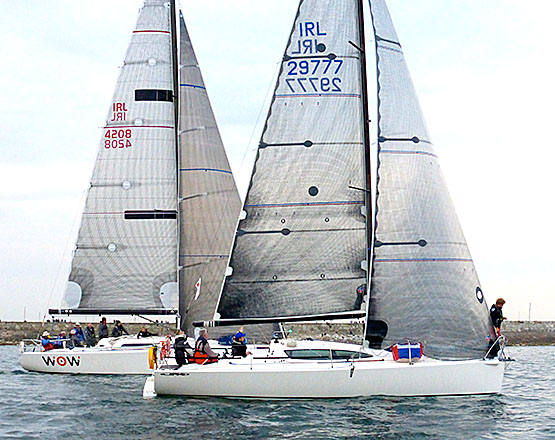Displaying items by tag: Volvo Dun Laoghaire Regatta
Should Dublin Bay Sailing Club Cruisers Zero & One Merge?
With just over six weeks to the Sherry Fitzgerald sponsored Dublin Bay Sailing Club season the stand–out class of the year looks like Cruisers One where a 20–boat fleet has 13 J/109s among its number. It's an impressive result that bodes well for a very competitive season but in the neighbouring big boat class should something be done to assist falling numbers in Cruisers Zero?
A story this week on Afloat.ie shows George Sisk's Wow from the Royal Irish Yacht Club is on the market. With only four other entries presently in DBSC Cruisers Zero is it now time to dispense with a Cruisers Zero class on Dublin Bay and rearrange the bands to take some lower–rated Cruisers One boats back into Cruisers Two?
Such a scenario is unlikely with the news that Sisk's WOW will be campaigned fully this season and a new Sisk forty footer is in the wings. In fact, there is also the possibility that Cruisers Zero could reach six boats this season with another new boat – yet to be announced – coming into the Bay.
There is also talk of DBSC moving the Cruisers One band lower to move some Cruisers One boats into Cruisers Zero but is that the answer?
Cruisers Zero was never that particularly strong in Dublin Bay and generally came about to ensure they got decent length races as the Cruisers One boats were considerably slower. However with the ever increasing speed of Cruisers One boats the gap in elapsed time between Cruisers Zero and Cruisers One has been reducing considerably.
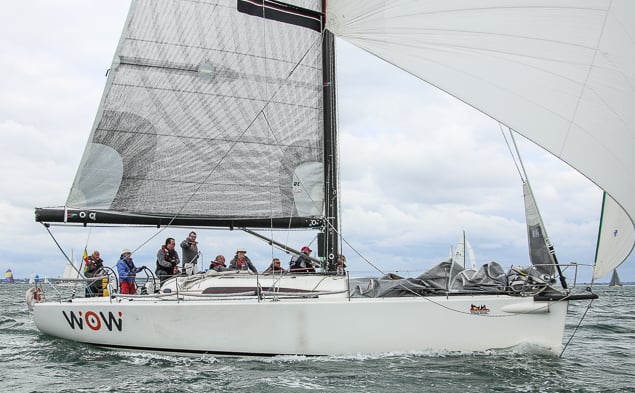 Cruisers Zero Farr 42 Wow is for sale but will be replaced with a similar sized boat Photo: Afloat.ie
Cruisers Zero Farr 42 Wow is for sale but will be replaced with a similar sized boat Photo: Afloat.ie
Cruisers One, spearheaded by the J109 designs, is clearly the strongest class in DBSC and likely in the country. Since the J109 class moved to non–overlapping jibs and consistently updated their sail wardrobes with the latest in sail technologies, they have been getting quicker and quicker.
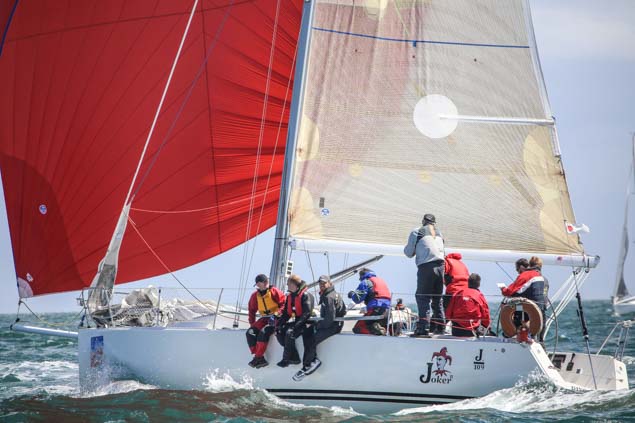 ICRA Boat of the Year, Joker 2, a J109 from the Royal Irish Yacht Club. Photo: Afloat.ie
ICRA Boat of the Year, Joker 2, a J109 from the Royal Irish Yacht Club. Photo: Afloat.ie
Three of the last four ICRA championships in Cruisers One have been won by J109’s including the last two years (Joker II) and the 2016 ICRA Boat of the Year is also a J109 (Joker II). A J109 also was a class winner in the Round Ireland race 2016 (Storm). The J109 class has pushed others in Cruisers One to up their game and now we see both the Archambault 35s Gringo and Adrenalin becoming much more competitive, along with the XP33 Bon Exemple that has gone through many changes over the last few year (symmetric to Asymmetric and back again, lowering their rating). Add to this Paul O'Higgins mighty Rockabill VI, the JPK 10.80, and Cruisers One is the strongest it has ever been.
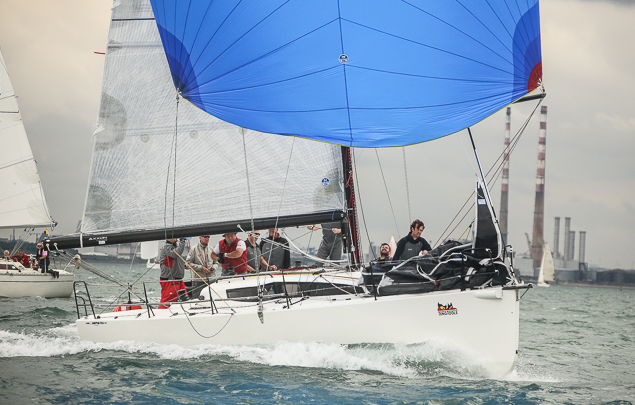 Paul O'Higgins mighty Rockabill VI, the JPK 10.80 design will be unstoppable in heavy airs. Photo: Afloat.ie
Paul O'Higgins mighty Rockabill VI, the JPK 10.80 design will be unstoppable in heavy airs. Photo: Afloat.ie
At the start of last season Tim Goodbody brought in the J109 White Mischief and two further J109’s have entered the fleet in the last six months, Andrew Algeo's Juggerknot and Andrew Craig's Chimeara. All three are seasoned campaigners and will surely drive the fleet further.
 Recent arrival – Tim Goodbody's White Mischief J109 was immediately competitive Photo: Afloat.ie
Recent arrival – Tim Goodbody's White Mischief J109 was immediately competitive Photo: Afloat.ie
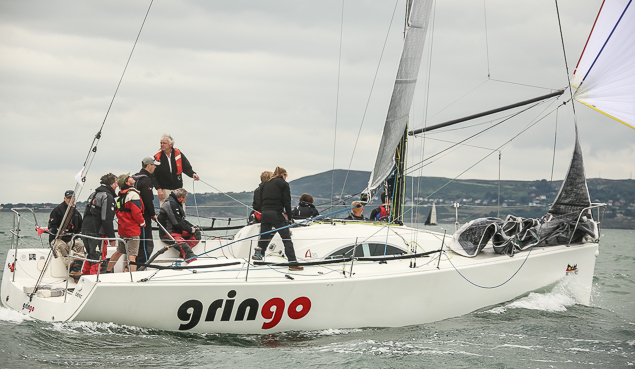 The A35 Gringo has a flatter stern and quick dead downwind. Photo: Afloat.ie
The A35 Gringo has a flatter stern and quick dead downwind. Photo: Afloat.ie
So who will be on the DBSC podiums this year in Cruisers One and also Cruisers One at ICRAs? With 13 J109’s competing surely the podium will be stacked with these 15–year–old designs? They are extremely competitive in lighter airs and can hold their own when the breeze gets up. Their only weakness is running in stronger winds where the lighter, and flatter sterned modern designs, like the A 35’s and XP 33’s can pull their poles back and go straight downwind, whereas the asymmetric J109’s have to do higher angles.
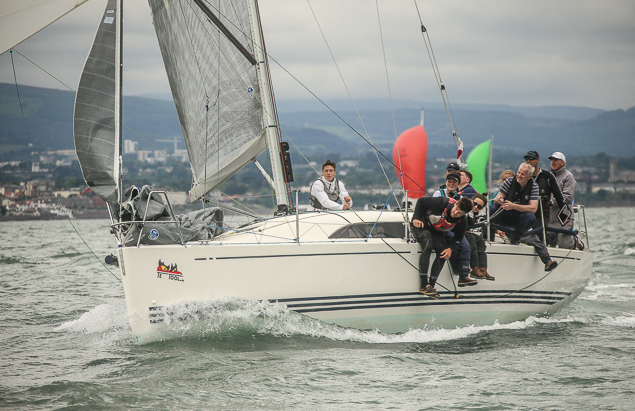 XP33 Bon Exemple – different spinnaker configurations. Photo: Afloat.ie
XP33 Bon Exemple – different spinnaker configurations. Photo: Afloat.ie
If, however, the winds stay stronger for a whole series, like ICRA's 2015, it will be very hard to beat Rockabill VI. This boat is extremely powerful and will go upwind and downwind much faster than the rest of the fleet in a breeze, even taking into account her higher handicap. However it appears she has a weakness in light airs and one day of these conditions in a series might be a problem for her.
Three in a Row for Joker II at ICRAs?
Among the J109’s the top performer from 2016, John Maybury's Joker 2 is going for three in a row at ICRA's having won in 2015 and 2016. She will not have it all her own way however as Tim Goodbody's White Mischief and Pat Kelly's Storm are always very competitive. The newly arrived Chimeara and Juggerknot might also have something to say. The A35 Gringo has shown a lot of form as has Bon Exemple. At ICRAs you will also likely be seeing the A35 Fools Gold of Rob O'Connell in contention as he has done in the last two events.
Packed Season
2017 is set to be a very interesting year for this ever strengthening class with 3 large events in Ireland for them to battle it out. The ICRA Championships in Cork Harbour in June, ten days later, Sovereigns Cup in Kinsale, and a few weeks after that Dun Laoghaire Regatta Some may also venture to Tarbert in Late May, Calves Week in Early August and Abersoch week in Late August. There are plenty of good events available and some great racing ahead. Allied to all of this a great regular racing scene in Cruisers One in the DBSC series.
ICRA Debate: Can Cruiser National Championships Afford To Be Stand Alone Event in Crowded Sailing Calendar?
The Irish Cruiser Racer Association must be applauded for providing a platform under the theme: 'we need to talk about cruiser racing' at tomorrow's conference in Limerick. Like an elephant in–the–room, the overcrowded Summer fixtures needs to be urgently addressed because it's not only the hosting clubs and competitors that suffer but the sport itself.
Between June 9 and July 9 Irish cruiser–racers have – in date order – the ICRA Nationals in Royal Cork YC (June 9–11), Sovereigns Cup at Kinsale Yacht Club, (June 21-24) Dun Laoghaire Regatta on Dublin Bay from (July 6-9) and Galway's WIORA on the Aran Islands from July 5–8.
On top of this, the biennial Dun Laoghaire to Dingle offshore race sets sail from the National Yacht Club for a three–day race on June 14.
These major events are icons of Summer sailing but how much do we lose by having them all within one month?
With a total available racing fleet of say up to 150 keelboats in Ireland, very few boats will do all five events, not least because WIORA and Dun Laoghaire regatta dates clash.
For many skippers, getting enough crew to do even two of these events will be an achievement in itself.
And, in what is becoming a well identified problem at club level, the successive nature of these events will certainly have a knock–on effect in crew availability for local racing.
Already Dublin Bay Sailing Club has taken a pragmatic approach and scrubbed its own long standing DBSC Cruiser Challenge because of this congestion.
It may seem blindingly obvious but it needs to be said, the Irish keelboat sailing calendar has just too many events for the times that are in it.
Does such congestion best showcase our sport? Attract sponsors or discourage them? And most importantly does it suit the sailors?
It's not the first time Water Rat has mentioned it. He raised it back in 2013 when one senior organiser saw fit to deny the situation and gave poor Water Rat a good talking to into the bargain. Unfortunately, the officer subsequently added that his muscular comments were off–the–record.
Four years later, nothing it appears, has changed except that new ICRA commodore Simon McGibney has invited all to the Limerick gabfest to talk about the future of cruiser racing.
Everyone supports the notion of the ICRA National Championships because it is an extremely worthy event that has, since its inception, done so much to raise the profile of cruiser-racing, an aspect of the sport hitherto poorly represented.
But in the current environment could this event not be included within a Sovereigns Week/Dun Laoghaire Week/Cork Week scenario thus reducing:
- crew demands
- volunteer fatigue within clubs,
- resources and logistics
- costs
At the same time, such a rejig would give a much needed boost to the regatta that would now include a 'National Championships'.
ICRA National Championship Must Keep its Own Identity
Equally, in such a set–up, it is essential the ICRA championship keeps its own identity. After all, it is a national championships, and that's the formula that proves popular with competitors, so it is vital it is not subsumed by any regatta.
ICRA could consider four year cycles. All the events to run from, say, a Wednesday to Saturday to maximise club takings. If it started next year then it could go to Cork Week, Dun Laoghaire in 2019, Howth 2020, Sovereign's in 2021 or some other rotation of this. A review could take place in year three of four to see if other venues wanted a piece of the action. Belfast, anyone? Existing venues also might want to drop out or change dates to fit the recast schedule.
This would not mean the ICRA Nationals concept falls away. On the contrary, ICRA instead works with the existing regatta committees to deliver it's goal of providing quality racing for IRC and ECHO boats and to enable the growth of the sport and to maximise the numbers of people afloat. This all happens. ICRA are merely using existing regattas as their vehicle to deliver. ICRA becomes more overseer than organiser and the regattas benefit from the additional UK exposure that ICRA manages to attract.
ICRA should be applauded for bringing everyone together to discuss this subject. Lets see what overhaul comes out of round table discussions at Castletroy.
Water Rat
Dun Laoghaire Bicentenary Sailing Regatta Takes on Interesting New Acts
With some visionary thinking by Cathy MacAleavey in her capacity as chief of the sub-committee organising the Classics, Traditional and Old Gaffers section of the Volvo Dun Laoghaire Regatta & Harbour Bicentenary Festival from June 6th to 9th, the scope of the event is going to become even more varied and certainly more colourful. As W M Nixon has discovered, she has been spreading the net wide:
“We’ve never been asked to take part in a regatta before. Never. So of course we’ll be there. And I personally am looking forward to it very much indeed.”
The speaker is Jack O’Keeffe of Cork, one of the main men in the Irish Drascombe Association, and also the overall association’s organizer of Rallies. While his members with their distinctive and extensive selection of tanned-sailed little boats are a familiar sight in Ireland and elsewhere as they stage their various rallies and other events, despite the well-known distinctive blue-green hull colour with which they were introduced being known throughout the country, nobody seems to have thought of them before as worthy participants as a class of their own. Not even as part of a menagerie class in a local regatta, let alone as playing a significant role in major events. But Cathy did her usual bit of lateral thinking, and the result is a whole new fleet for the Dun Laoghaire festivities.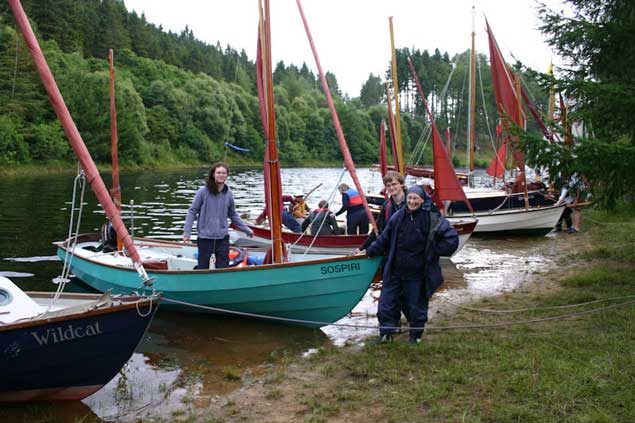 Traditional perceptions remember the Drascombes as all having that distinctive blue-green colour, but they’ve been multi-hued for years.
Traditional perceptions remember the Drascombes as all having that distinctive blue-green colour, but they’ve been multi-hued for years.
In Dun Laoghaire, the very fact that the Drascombes within their different types are broadly One-Design should see them encouraged, for in the home of One Design racing, it is only relative speed which is significant. Broadly speaking, every Drascombe will be sailing at much the same fairly leisurely speed, and they’ll all be manoeuvring in sync with that admirable Drascombe dignity. If that’s not a formula for good one-design racing, then I don’t know what is.
Yet while they may not break world sailing speed records, Drascombes certainly do sail – think of the Ogden brothers who sailed round Ireland in their Drascombe Lugger in some decidedly rugged conditions in 2015. Others, believe it or not, have crossed oceans. And on top of that, if they have managed to wend their way into the head of some peaceful creek at the end of day’s sailing, the lack of shore facilities is no problem, as most Drascombes provide rudimentary accommodation, quite commodious in some cases.
 "We’ve done it!” The Ogden brothers sail their Drascombe back into Baltimore at the completion of their round Ireland cruise.By a happy coincidence, 2017 is a special year, as it more or less marks the Golden Jubilee of the time Devon boat-builder John Watkinson started designing characterful seaworthy little boats which reflected the rigs of earlier times. It was in 1968 that he took the final 1967-built prototype to the London Boat Show and sold her within 20 minutes of opening, coming home with orders for 19 sister-ships to a concept whose popularity is proven by the fact of there now being 5,000 currently afloat.
"We’ve done it!” The Ogden brothers sail their Drascombe back into Baltimore at the completion of their round Ireland cruise.By a happy coincidence, 2017 is a special year, as it more or less marks the Golden Jubilee of the time Devon boat-builder John Watkinson started designing characterful seaworthy little boats which reflected the rigs of earlier times. It was in 1968 that he took the final 1967-built prototype to the London Boat Show and sold her within 20 minutes of opening, coming home with orders for 19 sister-ships to a concept whose popularity is proven by the fact of there now being 5,000 currently afloat.
The Golden Jubilee celebrations have already got under way with a party at the recent London Boat Show, but thanks to the Drascombe Association’s tradition of having the annual conference and dinner in the home town of the current overall chairman, the big party is going to be in Belfast City Hall on the weekend of March 25th to 26th, as the Drascombe Association’s Chairman of for 2017 is John Stanage of Belfast.
 A remarkable setting for the Drascombe Association’s Golden Jubilee celebration at the end of March 2017 – Belfast City Hall, completed in 1906, was an exuberant expression of a rapidly-growing city at the height of its industrial power.
A remarkable setting for the Drascombe Association’s Golden Jubilee celebration at the end of March 2017 – Belfast City Hall, completed in 1906, was an exuberant expression of a rapidly-growing city at the height of its industrial power.
Heaven only knows what Drascombe sailors from elsewhere will make of Ireland’s built environment if they attend the events both in Belfast in March, and in Dublin Bay in July. Belfast City Hall was such an exuberant expression of the city’s rocketing prosperity when it was completed in 1906 that its gloriously over-the-top Baroque Revival style was promptly copied by major civic buildings elsewhere. As for the rather more austere Kingstown Harbour - which will probably briefly revert to its imperial name during the Bicentenary Regatta - not only is the harbour a massively impressive structure on such a scale that it now seems a natural part of the bay, but its waterfront has a trio of yacht club buildings which, while the they don’t begin to match Belfast City Hall’s opulence, are quite something by comparison with your average sailing club.
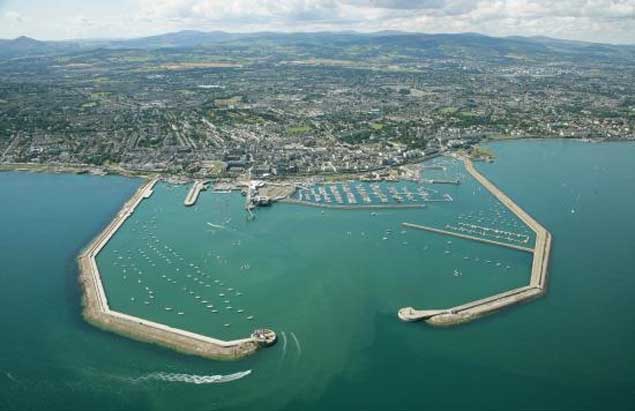 For smaller Drascombes, Dun Laoghaire Harbour is a complete cruising ground within itself
For smaller Drascombes, Dun Laoghaire Harbour is a complete cruising ground within itself
One of the reasons the Drascombes came up on the Dun Laoghaire radar is because the Sub-Committee were particularly impressed by the vibrant trailer-sailer section which is now to be found in the Old Gaffers Assocation, a section in which Drascombes play a signficant part.
It’s of interest that the OGA themselves have lately been paying closer attention to encouraging designs for smaller gaffers of good performance potential, and at the AGM in London last month, outgoing OGA President Sean Walsh of Dublin was able to unveil preliminary drawings of a concept by that versatile designer Andrew Wolstenholme of a 13ft 6ins “modern mini-gaffer” which the OGA wishes to encourage, with ease of amateur building a priority.
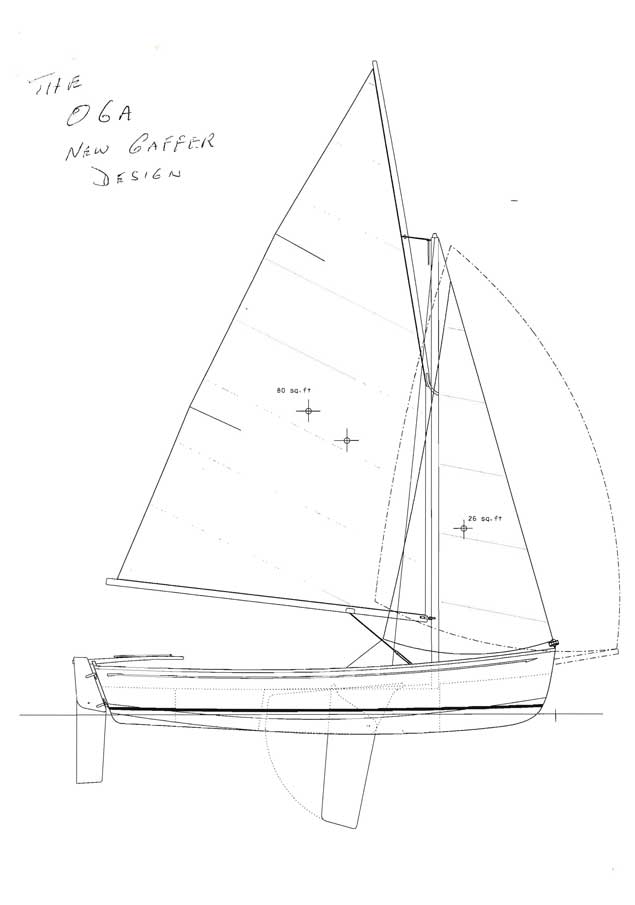 Concept drawing from Andrew Wolstenholme for the new 13ft 6ins “performance mini-gaffer” to be sponsored by the Old Gaffers Association
Concept drawing from Andrew Wolstenholme for the new 13ft 6ins “performance mini-gaffer” to be sponsored by the Old Gaffers Association
Equally Sean – who himself sails the 28ft Heard Falmouth Cutter Tir na nOg, a “plastic fantastic” – wished to record his own and the OGA’s appreciation of the work over the years of another boat designer from southwest England, and this is Roger Dongray, a house architect who many years ago found himself starting to design the little plastic gaffers which went on to become the Cornish range of Shrimpers, Crabbers and whatever, every one of them a characterful little boat which gives much pleasure and the extra sport of handling gaff rig to owners who have neither the resources nor skills to maintain an ageing wooden boat.
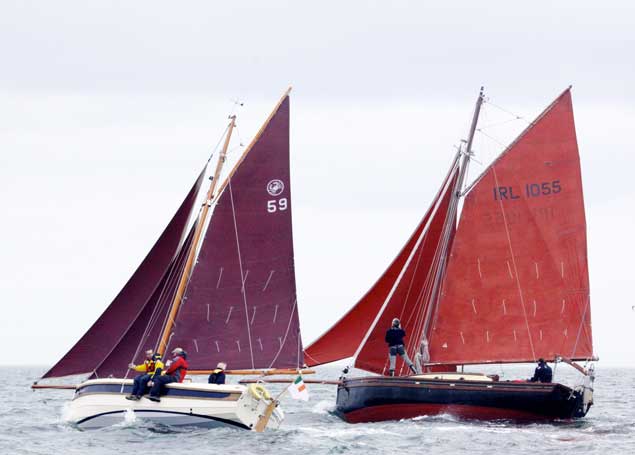 Dublin Bay OGA President Denis Aylmer’s Cornish Crabber Mona (left) and outgoing OGA President Sean Walsh’s Heard 28 Tir na nOg Photo: Dave Owens
Dublin Bay OGA President Denis Aylmer’s Cornish Crabber Mona (left) and outgoing OGA President Sean Walsh’s Heard 28 Tir na nOg Photo: Dave Owens
So Sean’s final duty before standing down, to be succeeded as President by Alistair Randall, was a formal presentation to acknowledge Roger Dongray’s special work in making gaffers interesting to modern-minded owners, and his skill in creating a recognisable style in a range of fibreglas-built gaff-rigged boats which are an adornment to any port or anchorage.
 The versatile Cornish Shrimper is one of Roger Dongray’s most popular designs.
The versatile Cornish Shrimper is one of Roger Dongray’s most popular designs.
In an era when the advent of foils means that we are seeing mono-hulls which have the potential to move at meaningless speeds, the sheer pleasure of coaxing the best performance out of a comfortable and characterful gaffer, aboard which your young family feels comfortable and secure, is something to be treasured, and it intrigued me to hear the other day that Olivier Prouveur, the Sailing Manager at the National YC and highly experienced in many kinds of craft, has bought himself a Cornish Shrimper as he reckons a boat like this provides very well for Dun Laoghaire sailing requirements – and yes, he does hope to race her for the Kingstown Cup in July.
Another area of possible participation where Cathy MacAaleavey has been casting her net is the three-masted Bantry Boats, but a problem she has discovered is that several are short of crews. One particular case is the one which was built in a community project at Banagaher on the Shannon, but unfortunately the key man in all this has moved on elsewhere, and they’ve a personnel problem.
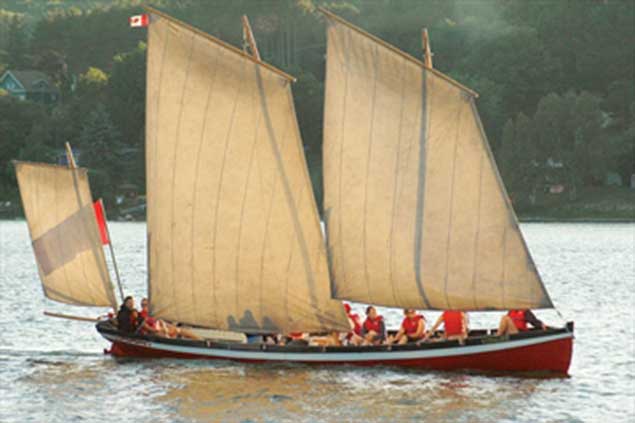 Bantry Boats need a lot of crew
Bantry Boats need a lot of crew
This in turn has opened up the possibility of the thriving coastal rowing clubs being a source of crewmen for the Bantry boats, for thanks to the enthusiastic support of the legendary Ger Ryan of St Michael’s Rowing Club underneath the arches beside Dun Laoghaire’s inner harbour, the outer harbour is going to be packed out with skiff racing crews from near and far on Sunday July 9th.
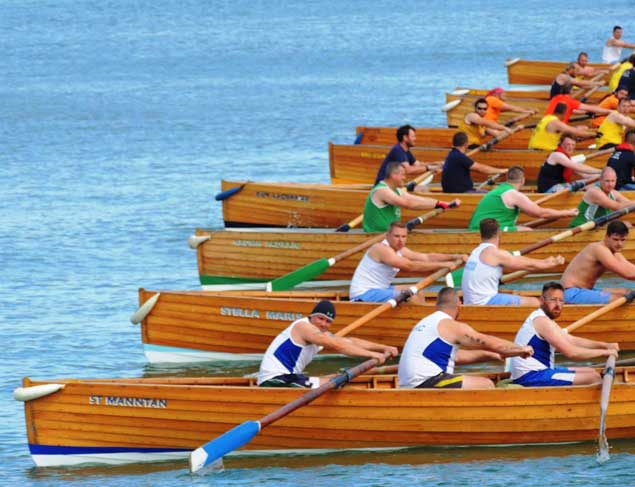 Manpower….the East Coast Rowing craft are an ancient style of boat going back to the era of the Dublin Bay hobblersFrom that comes the idea of an invitation being cast in the direction of the rowing skiffs of Strangford Lough. They’re much lighter and smaller boats than the traditional hefty East Coast craft which date back to the hobblers’ service boats of the 18th and 19th century. In Strangford Lough by contrast they used a highly-regarded Iain Ougthtred easy-build design, and a league developed as noted harbour pubs around the lough organized boat-building classes to provide an Oughtred skiff apiece. There are now nine boats which regularly turn out to race together, and it is of course thirsty work, which was probably the thinking all along.
Manpower….the East Coast Rowing craft are an ancient style of boat going back to the era of the Dublin Bay hobblersFrom that comes the idea of an invitation being cast in the direction of the rowing skiffs of Strangford Lough. They’re much lighter and smaller boats than the traditional hefty East Coast craft which date back to the hobblers’ service boats of the 18th and 19th century. In Strangford Lough by contrast they used a highly-regarded Iain Ougthtred easy-build design, and a league developed as noted harbour pubs around the lough organized boat-building classes to provide an Oughtred skiff apiece. There are now nine boats which regularly turn out to race together, and it is of course thirsty work, which was probably the thinking all along.
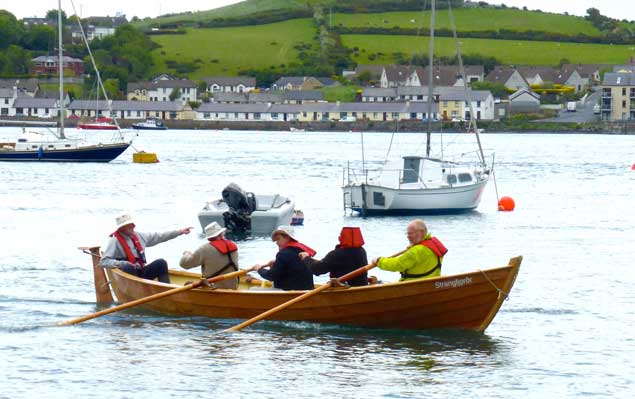 The Iain Oughtred-designed skiffs have established a league in Strangford Lough Photo W M Nixon
The Iain Oughtred-designed skiffs have established a league in Strangford Lough Photo W M Nixon
Whether or not they come to Dun Laoghaire in July is another matter altogether, interesting and all as it would be. But either way, we can be sure that the hugely varied fleet which is now shaping up for the Classics, Old Gaffers and Traditional Division of the Volvo Dun Laoghaire Bicentenary Regatta 2017 will find that whole-hearted participation is indeed very thirsty work.
Five Royal Irish yachts won free entry into July's Volvo Dun Laoghaire regatta following a draw from 180 'Super Early Bird entries' this week. In total 18 boats won the free entry prizes ranging from dinghies to IRC cruisers.
Among the winners are locals Peter Beamish's Beneteau 31.7 Camira, Ian Bowring's Sigma 33 Springer from the Royal St. George and the National Yacht Club Mermaid dinghy, Tiller Girl (Jonathan O'Rourke). Boats from outside the bay were also in luck including Christine Murray's IRC Cruiser Triple Elf from the Clyde Cruising Club and Mark Thompson's IRC Offshore entry Aquaplane from Pwllheli Sailing Club.
The full 'Super Early Bird Prize Draw Winners' are downloadable below as a PDF file.
ISORA's Peter Ryan anticipates a 50% increase in offshore sailors into next July's Volvo Dun Laoghaire Regatta. The buoyant prediction is in step with an encouraging ' Super Early Bird' entry for the biennial event that closed on New Year's Eve. Organisers received a fantastic response to the new Super Early Bird Entry draw with 178 fully paid entries received. The current entry now stands at 184 boats.
Entries have alrady been received from 31 of the 33 Regatta classes with great support from all the class captains who encouraged early entry within their fleets.
Fleets which currently have already over 10 boats entered (with still six months to close of entry) are Sigma 33, IRC Offshore, Non Spinnaker, IRC Cruisers, GP14 and IDRA 14 Classes.
An independently & professionally audited draw took place in the National Yacht Club on Monday 9th of January and 18 winners were selected across a number of classes and yacht clubs in IRL and UK (list of winners attached). These winners will have their entry fee fully refunded to them by the organisers.
A discounted 'Early Bird Entry' is open till 31st March 2017.
Dun Laoghaire Regatta Reports Strong Entry List: 111 Boats Now Entered for Biennial Regatta on Dublin Bay
In a pre-Christmas boost to next year's regatta season, over a quarter of the expected 400–boat entry have already entered next July's Volvo Dun Laoghaire Regatta on Dublin Bay.
The biennial event is staged by all four Dun Laoghaire waterfront clubs and has been growing ever since it was first staged on the bay in 2005.
Among the 111 boats already signed up is a healthy selection of crusier racers across all four divisions. A sign that the regatta is reaching out to all corners of the Irish Sea is the heartening response from Northern Ireland, Scotland, Welsh and English Clubs. In the Beneteau 211 class for example, a five boat entry to date has entries from Dun Laoghaire, Malahide, Windemere and The Clyde. See entry list below.
A 'Super Early Bird' reduced regatta entry fee remains open for another ten days and under the regatta rules for early entry, at least 11 boats now have the chance to win back their entry fee. Enter here
Other 2017 regattas around the country are also making a push for entries pre–Christmas
111 and counting: VDLR 2017 entries received at December 2017
420 GBR 54979 Daniel Thompson Wexford Harbour Boat & Tennis Club
Beneteau 211 Small Wonder IRL 7007 Hugh Kelly Royal Irish Yacht Club
Beneteau 211 MonReve IRL2113 Brian Stewart Malahide Yacht Club
Beneteau 211 Chinook IRL2121 Andrew Bradley Royal Irish Yacht Club
Beneteau 211 Carousel 362 Derek Beddows Windemere Motor Boat Racing Club
Beneteau 211 Carna GBR4167L Stu Spence Clyde Cruising Club
Beneteau 31.7 Levante IRL3107 John Power National Yacht Club
Beneteau 31.7 Crazyhorse IRL2004 Frank Heath Royal Irish YC / Royal St George YC
Beneteau 31.7 Prospect Irl 1565 Chris Johnston National Yacht Club
Beneteau 31.7 Camira IRL 2474 Peter Beamish Royal Irish Yacht Club
Beneteau 31.7 (Scratch & ECHO) Extreme Reality IRL 6909 Lorcan Balfe National Yacht Club
Classic Dinghy - Shannon One Design 178 Finn Murphy National Yacht Club
Classic Dinghy - Waterwag Mollie 41 Cathy Mac Aleavey National Yacht Club
Cruiser (IRC & ECHO) Checkmate XVIII GBR66R Performance Solutions Ltd Royal Irish Yacht Club
Cruiser (IRC & ECHO) White Mischief GBR1242R Richard Goodbody Royal Irish Yacht Club
Cruiser (IRC & ECHO) Rockabill VI IRL 10800 Paul O'Higgins Royal Irish Yacht Club
Cruiser (IRC & ECHO) D-TOX IRL 13500 Patrick McSwiney Royal Irish Yacht Club
Cruiser (IRC & ECHO) Dux Irl988 Anthony Gore-Grimes Howth Yacht Club
Cruiser (IRC & ECHO) Forty Licks GBR 4041R Jay Colville East Down Yacht Club
Cruiser (IRC & ECHO) Kamikaze IRL 8223 Peter Nash Royal St George Yacht Club
Cruiser (IRC & ECHO) Juggerknot IRL 3660 Andrew Algeo
Cruiser (IRC & ECHO) Injenious GBR2728L Mike Crompton South Caernarvonshire Yacht Club
Cruiser (IRC & ECHO) Checkmate XV IRL2016 David Cullen Howth Yacht Club
Cruiser (IRC & ECHO) RAPTOR IRL 811 DENIS HEWITT Royal Irish Yacht Club
Cruiser (IRC & ECHO) Eazi tiger 2909 Jonathan Oliver Liverpool Yacht Club
Cruiser (IRC & ECHO) JACOB VII IRL3307 John Stamp Port Edgar Yacht Club
Cruiser (IRC & ECHO) TRIPLE ELF FRA37296 Christine Murray Clyde Cruising Club
Cruiser (IRC & ECHO) Wynward irl307 McCormack Family Royal Irish Yacht Club
Cruiser (IRC & ECHO) Chase Me 397 John Raughter Bray Sailing Club
Cruiser (IRC & ECHO) STARGAZER GBR4203 ANGUS CAMPBELL Arran Yacht Club
Cruiser (IRC & ECHO) Movistar Bleu GBR 8747 Raymond Killops Killyleagh Yacht Club
Cruiser (IRC & ECHO) Starflash GBR7149 Alan Morrison Ballyholme YC / Royal Ulster YC
Cruiser (IRC & ECHO) Cacciatore IRL8069 Mairead Ni Cheallachain National Yacht Club
Cruiser (IRC & ECHO) Now or Never 3 GBR7667R Neill Sandford Fairlie Yacht Club
Cruiser (IRC & ECHO) Aurora GBR 7737R Roderick Stuart Clyde Cruising Club
Cruiser (IRC & ECHO) Warrior IRL8478 Dave Shanahan Dublin Bay Sailing Club
Cruiser (IRC & ECHO) TBA IRL1103 Kevin Darmody Howth Yacht Club
Cruiser (IRC & ECHO) Alpaca IRL 35221 Paul & Deirdre Tingle Royal Cork Yacht Club
Cruiser (IRC & ECHO) Prima Luce IRL 3504 Patrick Burke Royal Irish Yacht Club
Cruiser (IRC & ECHO) Ruthless IRL26026 Conor Ronan Dun Laoghaire Motor Yacht Club
Cruiser (IRC & ECHO) Challenger IRL6556 Paul Rossiter Howth Yacht Club
Cruiser (IRC & ECHO) Fusion IRL2552 Richard Colwell Howth Yacht Club
Dragon DCision 195 Joey Mason Royal St George Yacht Club
Fireball LICENCE TO THRILL IRL15007 LOUIS SMYTH COAL HARBOUR
Flying Fifteen Derranged IRL 3665 Neil Colin Dun Laoghaire Motor Yacht Club
Flying Fifteen FFASTIDIOTS 3837 Peter Cronin National Yacht Club
Glen Glen Luce G67 Richard O'Connor Royal St George Yacht Club
Glen GlenDun G9 David Houlton Royal St George Yacht Club
GP14 Trouble on the way TBA Curly Morris East Antrim Boat Club
GP14 14074 Cathal Sheridan Skerries Sailing Club
2017 Irish Sailing Regattas Open for Entry
Next year's three big Irish sailing regattas have set out their stalls early. The race is on to attract entries for July's Volvo Dun Laoghaire Regatta but before that there will be a fortnight of action on the South Coast with the Sovereign's Cup at Kinsale and the ICRA Nationals at Royal Cork both taking place in June.
The ICRA Notice of Race is published here and the Dun Laoghaire NOR is published here. Details on the 2017 Sovereign's Cup are here.
As an extra incentive all fully paid entries for VDLR received by 31st December will be automatically entered into a draw and 10% of these crews will have their entry fee refunded.
Organisers are expecting up to 31 Classes for the 2017 Regatta at Dun Laoghaire that also celebrates the bicentenary of its famous Harbour with a Classic Boat section.
2017 Dun Laoghaire Regatta Attracts 30 Entries In First Week of Online Entry
A week after opening its online entry Volvo Dun Laoghaire Regatta (and with eight months to the first gun) 29 entries have been received and six from overseas. The early entries are listed below.
It's a shot–in–the–arm for organisers of the biggest regatta in Ireland next year which will have an estimated final fleet of over 400 boats across 22 classes next July.
Adding an extra dimension to the 2017 regatta, a speical Kingstown 200 Cup will be presented to the the top classic yacht competing to honour the bicentenary of Dun Laoghaire Harbour.
Organisers have put in place a 'Super Early Bird Prize Draw' where all entries received and paid for in full by 31st December 2016 will automatically be entered into a draw and 10% of lucky skippers will have their entry fee refunded!
Early birds - entries recevied in first week
| Class | Boat Name | Name-First | Name-Last | |
| Cruiser Class | RAPTOR | DENIS | HEWITT | |
| Cruiser Class | Checkmate XV | David | Cullen | |
| Cruiser Class | Injenious | Mike Crompton | CROMPTON | |
| Cruiser Class | Juggerknot | Andrew | Algeo | |
| Cruiser Class | Kamikaze | Peter | Nash | |
| Cruiser Class | Forty Licks | Jay | Colville | |
| Cruiser Class | Dux | Anthony | Gore-Grimes | |
| Cruiser Class | D-TOX | Patrick | McSwiney | |
| Cruiser Class | Rockabill VI | Paul | O'Higgins | |
| Cruiser Class | XVIII | Checkmate | Performance Solutions Ltd | |
| Non Spinnaker | Just Jasmin | Philip | Smith | |
| Non Spinnaker | Spirit | Colin | O'Brien | |
| Non Spinnaker | Edenpark | Liam | Farmer | |
| Non Spinnaker | Poppy | John | Roberts | |
| Non Spinnaker | Vespucci | Sean & Kristina | O'Regan | |
| Non Spinnaker | Act Two | Michael | O'Leary | |
| IRC Offshore | AQUAPLANE | Mark | Thompson | |
| J109 | Chimaera | Andrew | Craig | |
| Sigma 33 | Gwili Two | Dermot | Clarke | |
| Sigma 33 | Elandra | Joe | Conway | |
| Sigma 33 | Springer | Ian | Bowring | |
| Sigma 33 | Legless Again | Dave | Hughes | |
| Beneteau 31.7 (Scratch & ECHO) | Levante | John | Power | |
| Beneteau 211 | Small Wonder | Hugh | Kelly | |
| J24 | Jelignite | Finbarr | Ryan | |
| Mermaid | The Message | Ross | Galbraith | |
| Mermaid | Aideen | Brendan | Martin | |
| Howth 17s | Oona | Peter | Courtney | |
| Howth 17s | Eileen | Rima | Macken |
Volvo Dun Laoghaire Regatta Notice Of Race 2017 Online
As part of the 2017 bicentenary celebrations of Dun Laoghaire Harbour, next July's Volvo Dun Laoghaire Regatta will be hosting a special event for “Classic” yachts to compete for the Kingstown 200 Cup.
Details of the regatta are now published in the official Notice of Race downloadable below. First thoughts on the Classic Cup were given by W M Nixon on Afloat.ie here.
Feeder races for Dun Laoghaire's four day regatta have been planned from Scotland, Northern Ireland, Wales and the west coast of England.
Event Chairman Tim Goodbody says 'we have a number of National and Regional events within the overall regatta which makes it more attractive for many to travel and compete'.
All entries received and paid for in full by 31st December 2016 will automatically be entered into a Super Early Bird Prize Draw and 10% of these lucky people will have their entry fee refunded.
The Irish Cruiser-Racer Association (ICRA) is a unique organisation. “Run by sailors for sailors”, it is nevertheless a very land-centric administrative body whose only manifestation afloat as a group with its own identity is seen at the organisation of the annual ICRA Nationals. And the sense of it relating purely to the island of Ireland is accentuated by the fact that much of its work is essentially back-office activity, dealing with handicaps and all the other paraphernalia involved in providing the nation’s numerous and very diverse cruiser-racer fleet with meaningful racing. W M Nixon went to last Saturday’s ICRA Conference to get a flavour of what ICRA does, and came away both impressed and stimulated.
Sweeping along southwestward towards Limerick on our wonderful motorway system, while one’s body stays firmly on the dual carriageway, the mind can wander into any pathways it wishes. So we got to thinking that, in this age of increasing numbers of administrators trained to third level degrees in the running of not-for-profit organisations, it’s a bit odd to find a very successfully central organisation which is apparently run – and well run at that - on a Corinthian basis “by sailors for sailors”.
Surely in today’s climate, which favours key bodies such as this being run by highly-trained specialists on at least a semi-professional basis, a seemingly amorphous organisation which is “run by sailors for sailors” is verging on a clear case of the asylum being taken over by the lunatics?
We’d soon see. Meanwhile, why on earth hold an annual conference in Limerick? With Ireland’s population distribution changing so rapidly, skewing both towards the large urban centres and particularly towards the east coast and Dublin, surely anyone organising a national conference would find it attendee-friendly to look at the latest map of population weighting. As it happens, I’m not sure that such a map exists, but we’d like to think that with today’s computers it is possible to construct a map where, after due calculation, you could pinpoint to the exact centre of Ireland’s total population distribution.
So you set out heading for Limerick at an unfeasibly early hour thinking that maybe a central location such as pretty Portlaoise or tidy Trim would probably be Ireland’s central point in relation to population distribution. But after some smooth time on the road with the sense of the wonderful west coast coming ever nearer, you begin to wonder why ICRA didn’t make a proper job of it, and take us to Dingle where we can breathe that wonderful Atlantic air and think great thoughts of sailing the high seas.

Far from the pressures of the cities of the east and south coasts, Dis-a-Ray is moored in the peaceful surroundings of Tarbert, where the south shore of the Shannon Estuary has already become part of the Kingdom of Kerry. Photo: W M Nixon
As it is, though the Dubs may think of Limerick as being on the western seaboard, it’s actually remarkably central when you draw lines across Ireland between all the best sailing locations. And as we knew that the position of Commodore of ICRA was going to pass on Saturday from Nobby Reilly of Howth (the Dingle of the East Coast) to Simon McGibney, Limerick was just about spot on in terms of equal travel time. For although the new Commodore has Foynes YC on the Shannon Estuary as his home club, his Dehler 101 Dis-a-ray is actually moored at his home at Tarbert which is further west down the Estuary, so much so that Tarbert is in the Kingdom of Kerry.
We arrived in to find a virtually full house distributed around a room-circling table such as they use for international diplomatic conferences to make peace with rogue states, with the layout being planned so that everyone can be an equal participant. It was grand for those of us who had arrived in the nick of time to get a seat, as we’d the fully-equipped table in front of us (did anybody else find it the devil’s own job to open the rather good but tightly-wrapped little sucky sweets which are essential to a talking shop?), but being Ireland several people arrived late, the show was already on the road, and they’d to find a seat as best they could.
All of which meant that there was a bigger turnout than expected, which is good news for ICRA. And for those of us comfortably ensconced, it made for a fascinating throughput of information by a long list of speakers, even though the layout meant that networking was restricted to the one hour lunch break if - like many people - you were relying on the 3.30-3.45pm wrap-up to facilitate returning to Dublin or Cork or wherever for a completely different event that night.
From the beginning, the dominant theme was on how we get more people into sailing, and everyone blithely talked as though we’re offering Joe Public a warm and sunny Croatian sailing product right here in Ireland, cheerfully ignoring the fact the last two summers have been plain lousy in terms of good weather.
Certainly the sailing was great for the enthusiast, but can you imagine a newcomer to the rough and ready sailing world wondering where on earth the attraction of it all was to be found as they were blown and bashed around at what we thought of as the utterly wonderful ICRA Nationals at Kinsale in June, or took in the all-too-typical variety of Irish summer weather at the hugely successful Volvo Dun Laoghaire Regatta in Dublin Bay in July?
Yet there is a fresh demand out there, and two of the morning’s speakers, Alistair Rumball of the Irish National Sailing School in Dun Laoghaire and Des McWilliam of McWilliam Sailmakers in Crosshaven, gave excellent talks on encouraging it, with Alistair showing us how his programme of moving beginners through dinghies and on into the school/club’s1720s, then became an inevitable progression into gaining experience and instruction on the school’s Prima 38 Lynx.
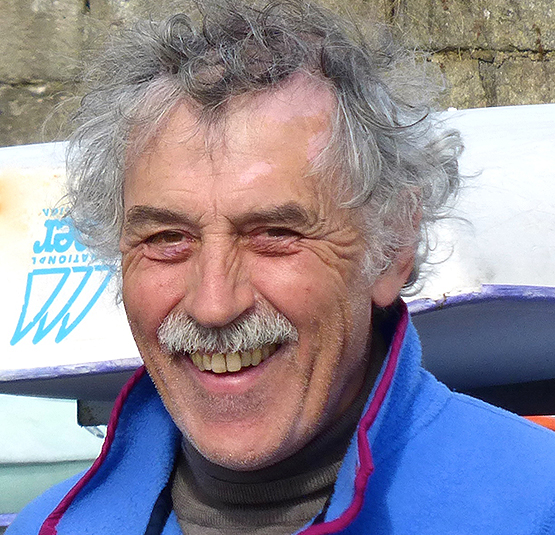 The mover and shaker. Alistair Rumball’s Irish National Sailing School in Dun Laoghaire is first port of call for many newcomers to sailing. Photo: W M Nixon
The mover and shaker. Alistair Rumball’s Irish National Sailing School in Dun Laoghaire is first port of call for many newcomers to sailing. Photo: W M Nixon
“Lynx has been a greater success than we could have ever dreamed of” he said. “She has been so booked out with people keen to learn about sailing a cruiser-racer that we haven’t been able to get as much actual racing with ISORA and so forth as we’d like. But for 2016, she’s being taken out of our Dun Laoghaire setup for long enough to be organised for a proper shot at the Volvo Round Ireland”.
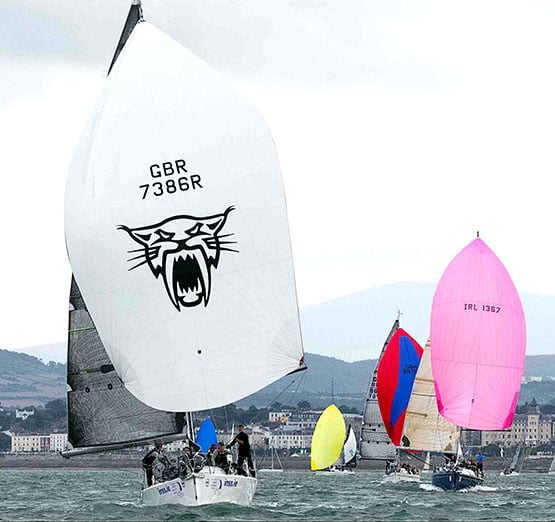
The double life of a Prima 38. The INSS’s Lynx in full racing mode in Dublin Bay (above), while below she is seen in early training mode as she takes a crew of beginners in cruiser-racing out for some formative experiences

As of last weekend in Limerick, there were just two crew places left aboard Lynx for this year’s Volvo Round Ireland on June 18th, and they’ve probably been snapped up by now. But the Rumball presentation underlined the fact that there are people out there who are mad keen to get into cruiser-racing, and it was up to ICRA to guide its members as to how best to tap into these wannabee sailors, instead of bleating all the time about how hard it is to find crew.
Des McWilliam leapt into the same theme, and gave us a crash course in how to make crewing on your boat more attractive to strangers. Admittedly the experience of seven years of acute economic recession have understandably made those who have kept boats in racing commission more than a little stressed. But if they want to reap the benefits of having struggled to stay in the boat-owning stream, then they have to make their cruiser-racers pleasanter to sail on, and more effective racing machines.
The McWilliam message was blunt in the extreme. “As a sailmaker in Ireland, each year I will race actively at many venues on upwards of 40 boats, both evenings and weekends. I will experience many different management and sailing styles. At the end of the year looking back, I usually realise that there might be only ten to a dozen boats out of that total of forty to which I would gladly and freely return for the good sport, the efficient sailing, the successful racing, the camaraderie – the fun. The rest of them are just work, involving duty visits. Please remember this when you are setting up the running of your boat, and trying to encourage people to sail with you.”
Des McWilliam of Crosshaven and Rory Staunton of Mayo. Des provided the meeting with some telling home truths about how attractive (or not) cruiser-racers throughout Ireland can be to sail on, while Rory Staunton led the charge in wondering why ORC and IRC cannot be amalgamated, and then went on to outline a new trailerable 33-footer he and an international group of friends are developing to make the incomparable west of Ireland a more accessible sailing area
We earned our lunch by going through an intensive session with Dobbs Davis of the Offshore Racing Congress, who had come to the conference with Zoran Grubisa to promote their measurement rule, which is used worldwide anywhere that IRC is not dominant, and in some key events such as the Rolex Sydney-Hobart Race, they are used in tandem, though IRC is currently the more-used system in that classic event.
It says everything about how Irish sailing punches way above its weight that these two guys thought it worth their while to come among us and evangelise for their system in a country which has a more-than-friendly relationship with the IRC and the people who run it. But it was fascinating stuff, making an input which added real spice to the day.
Davis is Chairman of the ORC’s Promotion & Development Committee, while Grubisa heads the Rating Officers Committee, and they run a system which is now the ISAF-approved rating method for the ISAF Offshore Worlds, which this year will be staged in Copenhagen in July, which as it happens is more or less the same time as the Royal Cork YC will be staging the new European IRC Championship in Volvo Cork Week at Crosshaven.
So the presence of the evangelists from the ORC at the ICRA conference could have opened up a right can of worms, but fair play to Dobbs Davis, he gave such an enthusiastic and lucid explanation of the completely transparent way in which ORC function that, for the time being at least, one’s instinctive loyalty to IRC was suspended out of intellectual curiosity.
Leading Offshore Racing Congress officers Zoran Grubisa (left) and Dobbs Davis were in Limerick to evangelise for the ORC Rating system
While IRC still has one or two hidden elements – the “Black Box” factor – with the transparency of ORC, you can always see how different inputs are effecting the final figure. One-design sailors may find all this utterly yawn-making, but as Davis pointed out, although there are so many successful cruiser-racer One-Design classes in America that ORC has yet to gain significant traction there despite being first set up in the US forty years ago, elsewhere in the world more and more people are coming to ORC as they enjoy watching boat innovation and performance analysis interacting to make their sailing more interesting and the results indicative of pure sailing ability.
The approachability of the ORC system was presented as one of its advantages
The slice of the cake worldwide for the different rating systems
But as we all know, where IRC and OCR are run side-by-side, despite the IRC’s hidden elements the two outcomes are often very similar. And in Ireland where we have a soft spot for the old S&3 34s which set world alight in 1969-73, the fact that the veteran though beautifully restored S&S 34 Quikpoint Azzura was overall winner of the Rolex-Sydney Hobart Race under OCR, after so nearly doing it on IRC, caused a bit of heart-searching. But nevertheless Rory Staunton from Mayo SC spoke for many when he demanded to know why IRC and ORC couldn’t get together and resolve their small differences for the general benefit of the offshore racing fraternity. Dobbs Davis said his door was always open, but that began to feel a bit too reminiscent of the current efforts to form a government, so we were glad enough to take a break for lunch and then return to the rating topic, but from an entirely different point of view
The inevitable expense in maximizing your boat’s performance potential under either IRC or ORC made the sheer economy of ICRA’s Progressive ECHO system seem immediately attractive, and the lead-in the afternoon session by SCORA Commodore Ronan Enright even more apposite. Because the fact is, you could run the Progressive ECHO Handicap System without even knowing what a boat looks like, let alone having her dimensions measured do the last millimtre.
Donal O’Sullivan of Dublin Bay SC, and Ronan Enright, Commodore SCORA, discussing sailing administration matters during the lunch break at Limerick. Enright went on to give an illuminating presentation about developments in Progressive ECHO Photo: W M Nixon
In the absence of ICRA’s ECHO supremo Denis Kiely - unavoidably absent for family reasons – Ronan Enright gave a quietly telling performance. It’s fascinating that though ECHO started life as the East Coast Handicap Organisation back around 1971-72, it’s now a nationwide service overseen by ICRA, and its most active area of development is in the cauldron of concentrated cruiser-racing which you find when the activities of Cork Habour and Kinsale are combined.
Basically, Progressive ECHO depends on the results of the most recent race, after which, if certain criteria have been fulfilled, the results are automatically re-computed to give boats a new rating based the supposition that they had all finished dead level on handicapped time. My own most recent experience of racing with it when it is being enthusiastically applied was in the Volvo Dun Laoghaire Regatta, which was a perfect test-bed for the system, as it was a compact series with the same fleet throughout.
The result is a series-long level of commitment by boats and crews who, under a more brutal system, would have seen their interest and enthusiasm flag after Day Two or even earlier. So really the message is: If we’re trying to get people to enjoy sailing and particularly to enjoy racing which is what the non-involved most easily comprehend, then Progressive ECHO is doing more to get bums on boats than anything else in Irish sailing, for believe me you have never seen anything quite so heart-warming as the response of a crew who, under One-Design or fixed handicap systems, had not been at the races at all, yet suddenly under Progressive ECHO they find they’ve recorded a win.
Which was all good news but perhaps the most interesting revelation of all from Ronan Enright was that the top IRC racers around Cork are now taking a closer interest in their Progressive ECHO showing than there are in their IRC results. For under IRC, they know they’ll be in the top six, but each post-race adjustment of Progressive ECHO gives them a very clear message about just how well or not they were really doing on the day.
Tom MacSweeney of this parish then hosted a forum which basically came down to how sailing can present a more friendly and accessible response to people who might be vaguely interested, and could be potential sailing enthusiasts. This involved him drawing on his training as a critical journalist, for as he admitted, when he first turned up with his first sailing boat – a Ruffian 23 – in Crosshaven, everyone from Denis Doyle downwards immediately made him welcome. But we can all think of non-assertive characters who are great sailors, yet if they hadn’t been in sailing families in the first place, they might not have taken up the sport at all owing to the sometime apparently closed nature of “yachting”.
We learned that very little of an Achill yawl is showing above the water after she capsizes. This is how they look in proper order
Allied to Des McWilliam’s incisive look at boats which you like to be aboard, and boats which you definitely don’t, and it all provided food for thought, as too did John Leech of Irish Water Safety with his no-nonsense presentation about a mature approach both to safety, and to being rescued. In an interesting mix of images, he showed us a photo of what happens to an Achill yawl when it capsizes. The result is an awful lot of rather waterlogged traditional boat under the surface, and only a little bit showing with the crew perched on top. As Des McWilliam was probably the only other person present with any idea of what an Schill yawl in full health looks like, the least we can do here is show you a photo of them in good sailing order. Meanwhile, John Leech concluded by saying that when you call out the ASR helicopters, think rather of how you can prevent your mast – if it’s still standing – from interfering with the rescue. Don’t for heaven’s sake use up emotional energy thinking about how much it all costs. They’re on standby all the time, and you the taxpayer have paid for them in the first place.
We concluded with Rory Staunton seeking interest and opinions for the new 33ft trailerable One-Design. While we all hope to get down to Clew Bay to sail the prototype this summer, could I suggest that one of the most exciting projects on the Irish cruiser-racer horizon is WIORA Week 2017 in the Aran Islands. So when they’ve finally got around to fixing a date, maybe the promoters of the new 33-footers could arrange to have a flotilla of them in Kilronan in 2017 to give the class a rocket-assisted launching.
Meanwhile this year’s WIORA West Coast Championship is under the auspices of the Royal Western of Ireland Yacht Club at Kilrush from June 29th to July 2nd. There’s so much extraordinary history in being able to write that simple bit of information that I reckon we’ll have to give it a complete blog in the future.
As for the ICRA Nationals, they’re at Howth from June 10th to 12th with both IRC and Progressive ECHO being used, while Volvo Cork Week comes up in July after the Volvo Round Ireland race has been tidied away in late June.
Although last Saturday’s Limerick gathering was essentially a wide-ranging conference, it was also the changeover to the new Commodore, with Simon McGibney taking on the mantle from the energetic and enthusiastic Nobby Reilly whose own boat, the Mills 36 Crazy Horse, was seen in virtually every event, and looked like heading for the win in Class at the ICRA Nats in Kinsale last June until new big winds swept George Sisk’s WOW to the fore. During Nobby’s busy time in the top office, ICRA’s activities and its reach steadily expand, while thanks to the persuasive efforts of Anthony O’Leary, a Commodore’s Cup team was assembled which regained the trophy in 2014.
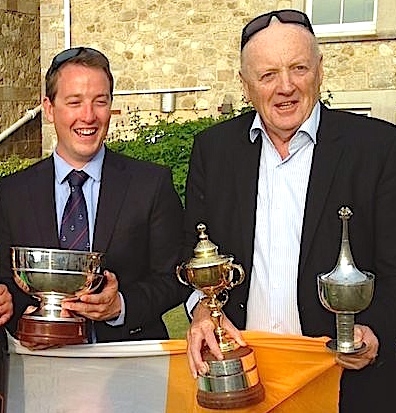 Ross MacDonald and ICRA Commodore Nobby Reilly at the Royal Yacht Squadron in Cowes in July 2014 after Ireland had won the Commodore’s Cup. At the ICRA Conference in Limerick last weekend, McDonald won a special award for his season’s results in 2015 with his X332 Equinox, while Nobby Reilly stood down after his successful years as Commodore, handing over the helm to Simon McGibney.
Ross MacDonald and ICRA Commodore Nobby Reilly at the Royal Yacht Squadron in Cowes in July 2014 after Ireland had won the Commodore’s Cup. At the ICRA Conference in Limerick last weekend, McDonald won a special award for his season’s results in 2015 with his X332 Equinox, while Nobby Reilly stood down after his successful years as Commodore, handing over the helm to Simon McGibney.
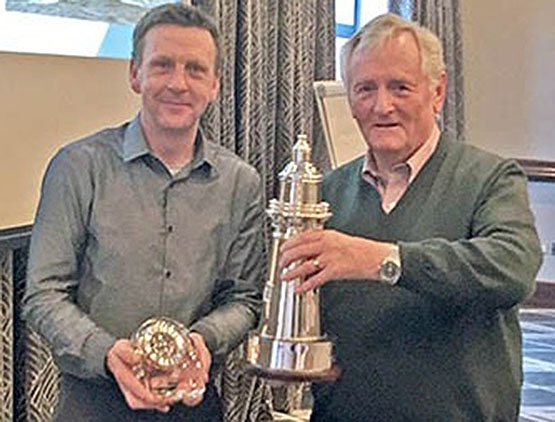
New ICRA Commodore Simom McGibney presents the “Boat of the Year” trophy to George Sisk of the Royal Irish Yacht Club, skipper of the Farr 42 WOW.
Work is going on behind the scenes to provide a strong defence this summer, but Anthony O’Leary wasn’t in Limerick to tell us about it, as he was away on his annual participation in America in the Viper 640 Championship, which just wouldn’t be the same if O’Leary wasn’t taking part - so much so that last year, he wasn’t present when his name came up as “Sailor of the Year” in Dublin, for he was away then too, Viper racing in the sun.
But other top sailors were there to round out the conference with the annual awards such as special performances by the likes of Dave Cullen with Checkmate XV and Ross Macdonald with Equinox and, while the ICRA Boat of the Year presentation, with warm acclamation, went to George Sisk of WOW, who not only admitted that his well-tested craft usually races with a crew of average age 53, but if he himself didn’t happen to be on board, the average age came down considerably………..And in case you think becoming ICRA Boat of the Year is all about glamour racing in sunshine, we close with a photo of WOW and the JPK 950 Alchimiste crawling towards the starting line for the Dun Laoghaire to Dingke race on the sort of damply windless evening that most folk would much prefer to spend comfortably at home.
It isn’t always glamour and warm sunshine and pleasant breezes. 2015 ICRA Boat of the Year WOW on a damp and windless evening approaching the start of the 280-mile Dun Laoghaire to Dingle race with the JPK 960 Alchimiste.


























